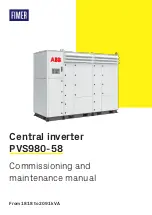
m2m Germany GmbH | Am Kappengraben 18-20 | 61273 Wehrheim | 06081 5873860
Whether a particular device includes all of these register types is up to the manufacturer. It is very common to find all I/O mapped to holding registers only.
Coilsare 1-bit registers, are used to control discrete outputs, and may be read or written.
Discrete Inputsare 1-bit registers used as inputs, and may only be read.
Input registersare 16-bit registers used for input, and may only be read.
Holding registersare the most universal 16-bit register, may be read or written, and may be used for a variety of things including inputs, outputs, configuration
data, or any requirement for
“holding”
data.
11.7 Modbus summarized
Use a twisted pair cable (shielded, if possible)
Check the polarity of the wires (different names for different manufacturers: A, B, D+,
D-
…)
Always place at least 1 termination resistor (at the end(s) of the bus)
Don’
t leave the termination resistor(s) without polarization. Place the bias resistors only in 1 point of the bus:
Avoid stubs:
Double check the addressing of the registers (standard, absolute, offset base 1, offset base
0…)
12 Declaration of conformity
Hereby, enginko Srl declares that MCF-LW06485 complies with the essential requirements and other relevant provisions of Directive 2014/53/EU.
13 FCC compliance for MCF-LW06485-US
This device complies with part 15 of the FCC Rules. Operation is subject to the following two conditions: (1) This device may not cause harmful interference, and
(2) this device must accept any interference received, including interference that may cause undesired operation.
This equipment has been tested and found to comply with the limits for a Class B digital device, pursuant to part 15 of the FCC Rules. These limits are designed to
provide reasonable protection against harmful interference in a residential installation. This equipment generates, uses and can radiate radio frequency energy and, if
not installed and used in accordance with the instructions, may cause harmful interference to radio communications. However, there is no guarantee that interference
will not occur in a particular installation. If this equipment does cause harmful interference to radio or television reception, which can be determined by turning the
equipment off and on, the user is encouraged to try to correct the interference by one or more of the following measures:
Reorient or relocate the receiving antenna.
Increase the separation between the equipment and receiver.
Connect the equipment into an outlet on a circuit different from that to which the receiver is connected.
Consult the dealer or an experienced radio/TV technician for help.
Any changes or modifications not expressly approved by the party responsible for compliance could void the user
’
s authority to operate this equipment.
Contains FCC ID: 2AWAL409810
14 Contacts
enginko Srl
Via Roma 3 I-28060 Sozzago (NO)
T : +39 0321 15 93 088
































